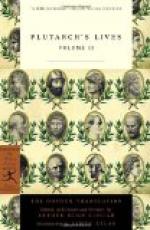[Footnote 261: Much has been written about this story, which cannot be literally true. The writings of Aristotle were not unknown to his immediate followers. If there is any truth in this story as told by Plutarch and Strabo (p. 608) it must refer to the original manuscripts of Aristotle. Part of the text of Plutarch is here manifestly corrupt. The subject has been examined by several writers. See art. “Aristotle,” Biog. Dict. of the Society for the Diffusion of Useful Knowledge, and Blakesley, Life of Aristotle, Cambridge 1839.]
[Footnote 262: This is Strabo the Geographer, but the passage is not in the Geography, and probably was in an historical work [Greek: Hupomnaemata historika], Strabo, p. 13) which he wrote, and which is cited by Plutarch in his Life of Lucullus, c. 28.]
[Footnote 263: These warm springs, which still exist, are on the west coast of Euboea, opposite to the mainland. They were much resorted to in Plutarch’s time, as appears from his Symposium (iv. Probl. 4). The place is named Galepsus in Wyttenbach’s edition, but in a note the editor admits that the true name is AEdepsus. Demetrius Calatianus (quoted by Strabo, p. 60), who had recorded all the earthquakes in Greece, says that the hot springs at Thermopylae and at AEdepsus once ceased to flow for three days owing to an earthquake, and those of AEdepsus, when they flowed again, broke out in a fresh place. The hot springs near Cape Therma in Euboea are supposed to be those of AEdepsus. They are more copious than the springs of Thermopylae on the opposite mainland, but of the same kind. “The water rushes down in a copious stream into the sea, the vapour from which is visible at a considerable distance.” (Penny Cyclopaedia, art. “Euboea.")]
[Footnote 264: Halaeae should probably be written Halae. It was near the Euripus, within Boeotia and on the borders of Phokia. (Pansaunias, ix. 24.)]
[Footnote 265: The usual passage from Italy to Greece and Greece to Italy was between Brundisium and Dyrrachium. Compare Appian, Civil Wars, c. 79.]




